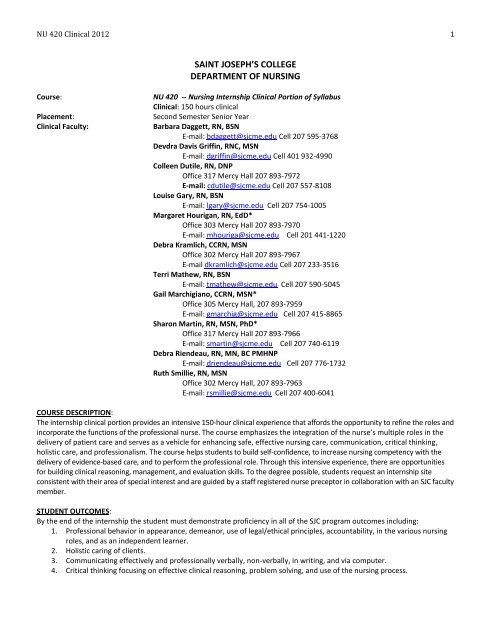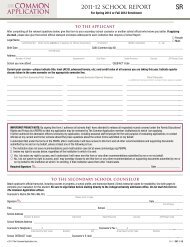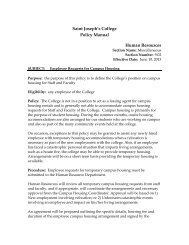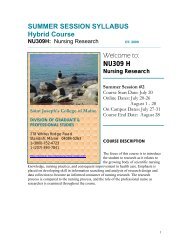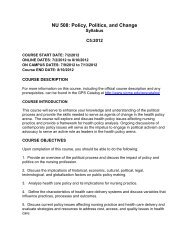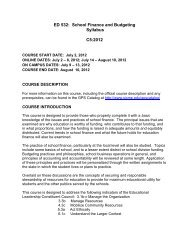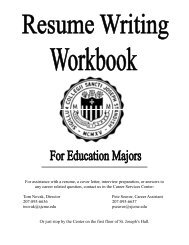SAINT JOSEPH'S COLLEGE DEPARTMENT OF NURSING
SAINT JOSEPH'S COLLEGE DEPARTMENT OF NURSING
SAINT JOSEPH'S COLLEGE DEPARTMENT OF NURSING
You also want an ePaper? Increase the reach of your titles
YUMPU automatically turns print PDFs into web optimized ePapers that Google loves.
NU 420 Clinical 2012 3used to document specific examples of the student’s: integration and synthesis of relevant theories and research;differentiation of pathophysiological changes; organization and prioritization of nursing care; demonstration of criticalthinking; application of decision making skills and judgment; delegation as appropriate; application of knowledge andprinciples of communication; consultation and collaboration with other health professionals; integration of client/familyeducation; implementation of professional standards of practice; and achievement of competencies in areas identified forclinical learning goals.When writing the journal entry for your clinical day, please discuss your clinical decision making in relation to a clinicalexperience. A sample journal is available on Angel1. Describe the clinical situation.2. Detail the nursing interventions performed by yourself or another.3. Describe what you would do differently, if anything, if a similar incident occurred.4. Relate parts of the clinical incident to the whole. What was going on in the situation and what were your cues?5 Apply previous knowledge from classroom or past experience. Did it help you or not? What resources did you use?6 Describe your areas of strengths and weaknesses in regard to this situation; include your thoughts, perceptions, andfeelings.7 Discuss agency standards of practice and policies and procedures relating how research evidence is translated intoclinical recommendations.8 Discuss quality and patient safety initiatives in the management of patient care.Faculty will return clinical logs with comments and/or questions. Students are expected to respond to the questions in a timelymanner.<strong>NURSING</strong> INTERNSHIP AGREEMENT:On or before the first day of clinical the student shall review and complete the NU 420 C Nursing Internship Agreement(ATTACHED) with the preceptor, the original to be returned to the clinical faculty. A duplicate is attached for the student andpreceptor to maintain as a reference.CLINICAL EVALUATION:Student clinical performance for the internship is graded. Students must meet criteria outlined on the Department of NursingOutcome Evaluation Tool designed for NU 420 . The faculty member, with preceptor input, will evaluate student clinicalperformance at the clinical midterm and at the end of the 150 required hours. The preceptor will also complete the formentitled, “Preceptor Evaluation of Student Performance” (ATTACHED) at the end of the 150 required hours and this becomespart of the final evaluation. Numerical grades will be calculated utilizing the Outcome Evaluation Tool at the end of thesemester.ACADEMIC ACCOMMODATIONS:Any student with a documented disability (physical, learning or psychological) needing academic accommodations shouldcontact Holly Sanborn in The Academic Center (328 Alfond Hall, ext. 7562) as early in the semester as possible. All discussionswill remain confidential. Please visit: http://www.sjcme.edu/academics/ for more information on disability services.<strong>SAINT</strong> <strong>JOSEPH'S</strong> <strong>COLLEGE</strong> <strong>OF</strong> MAINE’S PANDEMIC CRISIS MANAGEMENT PLAN:It is possible that a pandemic flu alert may close the College for two or more weeks during the course of an academicsemester. The College and its faculty understand the unusual nature of closing due to a pandemic crisis and will extend to itsstudents every consideration in accordance with its academic standards and goals.Should a closure due to a pandemic flu alert occur, each course being taught during the semester, including this course, willcontinue its instruction for students, to the extent possible, while they are at home. Therefore, students shall take their booksand instructional materials with them when they leave the campus and continue their reading and other assignments until theCollege reopens. To the extent possible, assignments and readings that would have been due during this period will be due atthe first class upon reopening. Assignments, readings, quizzes, and exams that would have been scheduled in the weeks afterreopening will be due according to the schedule in this syllabus. Instructors reserve the right to modify syllabi in the case of anemergency and to keep in touch with students through their media of choice.This syllabus may be changed, if necessary, at the discretion of the faculty.
NU 420 Clinical 2012 4<strong>SAINT</strong> JOSEPH’S <strong>COLLEGE</strong> <strong>DEPARTMENT</strong> <strong>OF</strong> <strong>NURSING</strong>NU 420 Nursing Internship AgreementStudent Nurse Responsibilities:The student nurse will:1. Identify and discuss own learning needs and establish learning goals by the first clinical experience and communicate these withthe preceptor and clinical instructor.2. Apply theoretical knowledge and nursing research to patient care.3. Follow unit/agency policies, procedures, and quality initiatives as well as professional ethics.4. Complete a total of 150 hours in a clinical practicum.5. Notify preceptor and faculty of schedule changes or absence.6. Self-evaluate clinical experience related to attainment of course and personal learning goals.7. Perform invasive procedures only under direct supervision of RN preceptor or preceptor designee.8. Perform only those nursing actions that the student is competent in and that are within the student’s scope of practice.9. Completes journal assignments as required and sends journals with the outcome tool within 4 days of the experience.Faculty Responsibilities:The faculty will:1. Assist the College and community agency in establishing a contractual agreement between the facilities.2. Serve as a liaison between the facility and College.3. Provide as needed to the agency verification that the student meets agency requirements including, but not limited to CPRcertification, immunizations, background checks, and HIPAA requirements.4. Provide and review with the preceptor the expectations of the clinical experience including the course syllabus, objectives, andevaluation criteria.5. Provide a means by which preceptor can contact faculty in the event of a problem or question.6. Contact preceptor regularly to ascertain student progress.7. Serve as a resource to student and preceptor while helping to meet learning needs identified by the preceptor for self or thestudent.8. Establish method and frequency of collaboration with preceptor and student regarding performance and progress.9. Complete the student's midterm and final evaluation based on input from student and preceptor.Preceptor Responsibilities:The preceptor agrees to:1. Provide clinical supervision, guidance, and role modeling for the student nurse while providing constructive feedback.2. Serve as a resource to the student.3. Orient the student to administrative policies, physical facilities, and standards of clinical and professional practice.4. Assist the student in the attainment of learning goals.5. Complete the attached evaluation form with the student at the end of the semester with participation in the student’s summativeevaluation.6. Notify the student and faculty of student performance that is less than expected immediately and confers with the faculty memberregarding the student’s performance and progress.7. Designate a substitute preceptor of similar qualifications to work with student in her/his absence.8. Directly supervise or arrange for another qualified person to directly supervise the student performing any invasive procedure or IVbolus medication throughout the semester.9. Discovers and follows agency policy and procedures concerning a student performing an invasive procedure. (SJC nursing facultyreserve the right to restrict invasive procedures that a student may perform)Qualifications of Staff Nurse Preceptors:The preceptor must:1. Have a current license as a Registered Nurse.2. Have a minimum of one year of full-time nursing experience.3. Voluntarily participate as a preceptor in the student’s clinical internship experience.4. Be able to give constructive feedback.5. Enjoy working with a student.STUDENTFACULTYPRECEPTORDATE
NU 420 Clinical 2012 5<strong>SAINT</strong> JOSEPH’S <strong>COLLEGE</strong> <strong>DEPARTMENT</strong> <strong>OF</strong> <strong>NURSING</strong>NU 420 Nursing Internship AgreementThe student nurse will:1. Identify and discuss own learning needs and establish learning goals by the first clinical experience and communicate these withthe preceptor and clinical instructor.2. Apply theoretical knowledge and nursing research to patient care.3. Follow unit/agency policies, procedures, and quality initiatives as well as professional ethics.4. Complete a total of 150 hours in a clinical practicum.5. Notify preceptor and faculty of schedule changes or absence.6. Self-evaluate clinical experience related to attainment of course and personal learning goals.7. Perform invasive procedures only under direct supervision of RN preceptor or preceptor designee.8. Perform only those nursing actions that the student is competent in and that are within the student’s scope of practice.9. Completes journal assignments as required and sends journals with the outcome tool within 4 days of the experience.Faculty Responsibilities:The faculty will:1. Assist the College and community agency in establishing a contractual agreement between the facilities.2. Serve as a liaison between the facility and College.3. Provide as needed to the agency verification that the student meets agency requirements including, but not limited to CPRcertification, immunizations, background checks, and HIPAA requirements.4. Provide and review with the preceptor the expectations of the clinical experience including the course syllabus, objectives, andevaluation criteria.5. Provide a means by which preceptor can contact faculty in the event of a problem or question.6. Contact preceptor regularly to ascertain student progress.7. Serve as a resource to student and preceptor while helping to meet learning needs identified by the preceptor for self or thestudent.8. Establish method and frequency of collaboration with preceptor and student regarding performance and progress.9. Complete the student's midterm and final evaluation based on input from student and preceptor.Preceptor Responsibilities:The preceptor agrees to:1. Provide clinical supervision, guidance, and role modeling for the student nurse while providing constructive feedback.2. Serve as a resource to the student.3. Orient the student to administrative policies, physical facilities, and standards of clinical and professional practice.4. Assist the student in the attainment of learning goals.5. Complete the attached evaluation form with the student at the end of the semester with participation in the student’s summativeevaluation.6. Notify the student and faculty of student performance that is less than expected immediately and confers with the faculty memberregarding the student’s performance and progress.7. Designate a substitute preceptor of similar qualifications to work with student in her/his absence.8. Directly supervise or arrange for another qualified person to directly supervise the student performing any invasive procedure or IVbolus medication throughout the semester.9. Discovers and follows agency policy and procedures concerning a student performing an invasive procedure. (SJC nursing facultyreserve the right to restrict invasive procedures that a student may perform)Qualifications of Staff Nurse Preceptors:The preceptor must:1. Have a current license as a Registered Nurse.2. Have a minimum of one year of full-time nursing experience.3. Voluntarily participate as a preceptor in the student’s clinical internship experience.4. Be able to give constructive feedback.5. Enjoy working with a student.STUDENTFACULTYPRECEPTORDATE
NU 420 Clinical 2012 6<strong>SAINT</strong> JOSEPH’S <strong>COLLEGE</strong><strong>DEPARTMENT</strong> <strong>OF</strong> <strong>NURSING</strong>NU 420C Nursing InternshipPRECEPTOR EVALUATION <strong>OF</strong> STUDENT PERFORMANCE(Completed by preceptor + student at the end of the internship experience)STUDENTCLINICAL AGENCYFACULTYPRECEPTORCLINICAL HOURS COMPLETED:ADHERED TO UNIT AND INSTITUTION POLICIES, PROCEDURES, AND QUALITY INITIATIVES:____________________________________________________________________________________________________DEMONSTRATED CONTINUED PROGRESS IN LEARNING SKILLS AND THEORY:EXAMPLES:DEMONSTRATED INCREASING ABILITY TO PERFORM NURSE ROLE INDEPENDENTLY INCLUDING THE DELIVERY <strong>OF</strong> SAFE<strong>NURSING</strong> CARE, THE USE <strong>OF</strong> EFFECTIVE COMMUNICATION, AND THE INTEGRATION <strong>OF</strong> LEADERSHIP BEHAVIORS:EXAMPLES:RECOMMENDATIONS <strong>OF</strong> PRECEPTOR FOR FUTURE STUDENT GOALS/LEARNING:STUDENTFACULTYPRECEPTORDATE
NU 420 Clinical 2012 7INTERNSHIP DOCUMENTATIONCLINICAL DATES HOURS CUMMULATIVEHOURSPRECEPTOR/DESIGNEE SIGNATURE
NU 420 Clinical 2012 8Guidelines for a Unit PresentationDuring internship, the student may elect to present an oral or poster presentation on a clinical topic identified by the management team atthe sponsoring agency. The presentation needs to be developed in conjunction with SJC faculty as well as with any of the following: the uniteducator, the precepting nurse, the nurse manager of the student’s internship unit, +/or the staff of the educational department of thehospital where the student is completing internship. The presentation should include the following areas:‣ Evidence-based nursing care‣ Pathophysiology and pharmacotherapy as applicable‣ Safety and infection control issues‣ Holistic approach to care‣ Quality initiativesThe student presenting should conduct a thorough literature review to ensure that the presentation reflects the latest EBP. Though thepresentation is not required or graded, it does offer the opportunity for the student to earn a 4 or 5 in various NU 420 course outcomes andthus potentially can improve the internship grade. Earning 4 or 5 on various outcomes can be attained by: taking initiative to initiate the presentation at least 4 weeks in advance, working consistently with the SJC faculty and hospital representative during presentation preparation, meeting all deadlines without reminder, demonstrating a thorough review of available EBP on the topic including at least guidelines available through the NationalGuideline Clearinghouse www.ngc.gov and the Cochrane database of systematic reviews, which are available through our SJClibrary, not just what is easily available via full-text e-journals, forwarding the complete and final version of the presentation to SJC faculty and the hospital representative at least one weekbefore the scheduled presentation date. This allows time for final revisions as neededNU 420 Presentation CriteriaRESEARCH for the PRESENTATIONCommentsLiterature review includes 3-6 timely, appropriate articles on the topic. Theliterature review should be shared with faculty 2 weeks before the presentation.At least one article in the literature review is research based. Cochrane Review andNational Guideline Clearinghouse are represented in the review.Research is current (articles and guidelines within 5 years).Emphasis is placed on content/information that is most important for audience toknow. “Must know material” over “nice to know.”Presentation learning outcomes (2-5) are appropriate.FINAL PRESENTATIONReferences are included throughout the presentation and correctly cited.Final presentation is given to the SJC faculty and hospital representative at least oneweek prior to the presentation.Final presentation grammar, spelling and punctuation are correct.Final presentation demonstrates student has spell-checked and proofread material.Final presentation is well-sequenced (follows logical order).Final presentation demonstrates significant effort in terms of time (meetingdeadlines), work, and quality.UNIT PRESENTATIONReferences are included throughout the presentation and correctly cited.Holistic nursing care considerations are covered.Key points are stressed.Intermittent summarizations are used if applicable.Inclusion of audience occurs if applicable.Effective use of visual aids and handouts occurs if applicable.Natural, supportive movements and gestures are used if applicable.Sustained eye contact with the audience occurs if applicable.Clear, well-paced voice is used if applicable.Summary of major concepts occurs (take home messages at the end).Professional demeanor is apparent (dress, hair etc.)Evaluation of audience’s knowledge occurs.Questions are answered with accurate, knowledgeable response. If answer is notknown, presenter establishes a mechanism to respond to audience.Narrative Feedback:Modified with permission: The Curriculum Project
NU 420 Clinical 2012 9INTRAVENOUS THERAPY POLICYPOLICY FOR INSERTING A PERIPHERAL-SHORT OVER-THE-NEEDLE CATHETERPOLICY – Students must follow the agency policy and procedure regarding I.V. insertion. After meeting the agencyrequirements, this policy applies to all SJC nursing students who have successfully completed the IV insertion labCannulas are placed for definitive therapeutic and/or diagnostic indications. The smallest gauge, shortest length cannulacapable of accomplishing the prescribed therapy shall be used. The supervising R.N. and hospital policy will determine adultpatient selection. The student will be limited to two attempts per patient, if the patient is willing.Based on standards of the Infusion Nurses Society (INS), the placement of catheters shall be in accordance with the stateNurse Practice Act. The catheter selected shall be the smallest gauge and shortest length that will accommodate theprescribed therapy. Aseptic technique shall be used and standard precautions observed during catheter placement. Only onecatheter shall be used for each cannulation attempt (Phillips, 2010, Manual of I.V. Therapeutics).*****************************COMPETENCY CRITERIA: Initiation of Peripheral I.V. Therapy following the Phillips Steps. (Phillips, 2010, Manual of I.V.Therapeutics)COMPETENCY STATEMENT: Competent I.V. nurses will be able to perform venipuncture technique for support of peripheralI.V. therapy.NOTE: The cognitive (knowledge) information that is embedded within this performance-based competency includes aseptictechnique, manufacturer recommendation for use of equipment, venous anatomy and physiology, fluid and electrolytebalance. This competency links to the competency of infection control, management of I.V. equipment, and parenteralsolutions.CRITICAL ACTION STEPSEquipment NeededIV start kit (if available)Clean glovesIV catheter (size/gauge dependent on need)Prep solution (chlorhexidine gluconate recommended)Non latex tourniquetTransparent semipermeable membrane (TSM) dressingLocking device with needleless valve (T connector/clave primed with sodium chloride flush syringe) and if appropriate IVinfusion set-upLocal anesthetic (Based on authorized prescriber’s order)Pre Cannula Insertion1. Verifies authorized prescriber’s order.2. Uses proper hand hygiene through the use of either a waterless, alcohol-based hand rub product or an antimicrobialsoap and water hand washing for 20 sec with adequate rinsing (CDC Guideline).3. Gathers equipment, performs an inspection of I.V. equipment to ensure product integrity, and prepares equipment. (e.g.T connector primed with an attached normal saline flush)4. Introduces self to the patient.5. Checks patient ID using two patient identifiers (Checks ID bracelet and asks patient to state name. (Joint Commission SafetyGoal)6. Provides privacy. Explains procedure and gains the patient’s verbal consent. Also, interviews the patient regarding previous
NU 420 Clinical 2012 10experiences with I.V. therapy and psychological preparedness. Assesses the desire for the administration of local analgesiaand verifies allergy status. Obtains an order, as appropriate, for local analgesia such as intradermal 1% Lidocaine. Someagency and unit-based policies include the use of a local anesthetic. In this case, a new authorized provider order is notnecessary. Agency policy must be followed when using topical anesthetic cream or a local intradermal anesthetic.7. Helps patient into a comfortable position. Places a linen saver under arm or hand. Applies tourniquet and examines botharms for the best access site to support I.V. therapy. Preferred sites are those with the lowest risk of complication. Theseare the metacarpal, cephalic, and basilic veins of the hand and forearm. Choose the most distal veins of the upperextremity. Where possible avoid dominant arm and areas of flexion. If a patient has a condition with poor vascular venousreturn, the affected side must not be used (e.g. mastectomy or fistula arm). Release tourniquet. Note: Hair over theinsertion site should only be removed with scissors or clippers. Shaving can cause microabrasion and increase the risk ofinfection.8. Wash hands again before beginning the procedure and don gloves. (Gloves must be left on throughout the procedure)Cannula Insertion.9. Applies tourniquet 6-8 inches above the planned venipuncture site. Note: If using 1% Lidocaine, prep the site with 70%alcohol for 30 seconds and allow it to dry. Administer by intradermal injection the ordered mL amount of 1% Lidocaine(usual dose is 0.1 mL). Release tourniquet. Allow 30 seconds for the effect of the anesthetic to begin.10. Prepares a 2-3 inch site by using a 30-second vigorous scrub working back and forth with friction using chlorhexidinegluconate with alcohol (ChloraPrep). Agency policy regarding the prep solution should be followed. Allow the antiseptic toremain on the insertion site and to air dry before catheter insertion. Do not remove. Do not retouch.11. Performs venipuncture technique:A. With tourniquet on, use the direct or indirect method. Approach depends on patient situation.Review your text (pp. 370) on the direct (one-step) insertion technique penetrating the skin andvein simultaneously versus the indirect (two-step) method with insertion into the skin alongside anddistal to the point at which the vein will be entered. The indirect technique is advantageous forpatients with small, delicate veins. Review special techniques for patients with paper-thin skin, forobese patients, or with veins that roll (pp. 390-391).B. Insert the catheter at an angle of 20-degree to 30-degree to enter skin with the bevel up. (Mayrequire a lower 10-20 degree angle in an older adult) while applying traction to the vein with thethumb of the opposite hand.C. After the bevel enters the vein and a blood flashback occurs, lower the angle of the catheter andstylet (needle) as one unit and advance into the vein. After the catheter tip and bevel are in thevein, advance the catheter forward off the stylet and into the vein. Hold the catheter hub with yourthumb and middle finger and use your index finger to advance the catheter, maintaining skintraction with the opposite thumb. Advancing the cannula must be done cautiously. A one-handedtechnique is recommended to advance the catheter off the stylet so that the opposite hand canmaintain proper traction on the skin. A two-handed technique can be used, but this increases therisk of vessel rupture during threading.D. While the stylet is still partially inside the catheter, release the tourniquetE. Remove the stylet. Most over-the-needle cannulas have a safety mechanism that will allow theneedle to retract into its housing, thus avoiding any needle exposure.F. Connect the hub of catheter to the pre-primed locking device or administration set using a twistingmotion.G. Stabilize the catheter hub with a stabilization device or apply a transparent semipermeablemembrane (TSM) dressing or a 2-inch X 2-inch gauze dressing with all edges taped. The type ofdressing will depend upon patient-specific variables (i.e. diaphoresis, allergy) and agency policy. Thecannula needs to be stabilized in a way that does not interfere with assessment or delivery of
NU 420 Clinical 2012 11therapy. Dressings applied with aseptic technique are recommended to be changed whenever theintegrity of the dressing is compromised (damp, loosened, or visibly soiled).Post Cannula Insertion12. Labels the insertion site with the cannula size, date, time, and initials. Disposes equipment using OSHA andJACHO standards. Teaches the patient regarding limitations and information concerning the equipment beingused. Also, informs the patient that the insertion site will be carefully monitored and to inform the providerabout any pain or discomfort.13. Calculates the I.V. infusion rate accurately, if applicable, label tubing and IV solution.14. Documents initiation of peripheral I.V. therapy based on institution policy and procedures.A. Date and Time of InsertionA. Gauge and length of cannulaB. Use of a local anesthetic, if appropriateC. Number of attempts and any complicationD. Location of catheter (specify vein) and blood returnE. Use of equipment (electronic infusion devices, inline filters, extension sets, sealable lock).F. Solution infusing and rate.G. Site assessment scale (i.e. visual infusion phlebitis assessment scale (VIPAS) scale)B. Patient responseC. Signature with credentialsEVALUATION CRITERIA1. Observation of initiation of I.V. therapy on a manikin.2. Observation and review of documentation.(Revised November 2005, 2008, 2009, 2010, 2011)IV Insertion Day – NU 420Learning Objectives:The student will:1. Relate the Saint Joseph’s College Policy on intravenous therapy.2. Indicate the anatomy and physiology of the peripheral venous system of the upper extremities.3. Specify factors that affect peripheral IV site selection and use of appropriate upper extremity veins.4. Discuss the meaning of medical and surgical asepsis.5. Demonstrate Phillips’ Stepped approach for initiating IV therapy.6. Comprehensively document the initiation of IV therapy.7. Relate the CDC and INS guidelines for placement and management of intravascular catheters in adults andchildren.8. Discuss complications of peripheral IV therapy and measures for prevention.9. Calculate dosage and flow rates for drug infusions including infusions based on kilogram body weight.
NU 420 Clinical 2012 1210. Identify complications of IV therapy.11. Relate safety measures and quality initiatives when performing IV therapy.Reading:Phillips, L. (2010). Manual of I.V. Therapeutics 5 th Ed., Philadelphia: F.A. Davis.Chapter 6: Techniques for Initiation and Maintenance of Peripheral Infusion Therapy pp. 303-401 (see key points on p. 388-393). Identify the hand or arm veins on p. 379. This anatomy is an important component of your documentation.Review Chapter 9: Complications of Infusion Therapy pp. 546-596 (from NU 301).Curran, A. (2005). Math for Meds 9 th Ed., San Diego: W. I. Publications, Inc. Chapter 18, IV Medication and TitrationCalculations, pp. 257-274. Review CH 19. Heparin Infusion Calculations, pp. 275-278.orCurran, A. (2010). Math for Meds 10 th Ed., San Diego: W. I. Publications, Inc. Chapter 20, IV Medication and TitrationCalculations, pp. 309-33. Review CH 21, Heparin Infusion Calculations, pp. 331-334.Centers for Disease Control and Prevention. (2011). Guidelines for the prevention of intravascular catheter-related infections.(Special emphasis on the recommendations discussed on pp. 9-20). The document may be accessed online athttp://www.cdc.gov/hicpac/BSI/BSI-guidelines-2011.htmlAssignment:Saint Joseph’s College Medication Calculations found in A Guide for the JourneyPhillips (2010) – pp. 384-385 Post-test; Optional: Math calculations pp.381Curran 9 th Ed. (2005) – Please complete practice problems p. 260 (Questions 1-5), pp. 262- 263 (Questions 1-5), pp. 270(Questions 1-5), pp. 271-274 Summary Self Test.orCurran 10 th Ed. (2010) - Please complete practice problems pp. 311-312 (Questions 1-5), p. 314 (Questions 1-5), p. 327(Questions 1-5), pp. 328-330 Summary Self TestNursing Lab Schedule:0900 – 1000 – Math10:00 – 11:00 – IV insertion guidelines and standards based on the INS, CDC, and SJC policy.11:00 – 12:00 – IV Jeopardy12:00 – 1230 – Lunch12:30 – 3:30 – IV insertion skill practice (Stations: IV insertion, ID 1% Lidocaine; Infusion therapy guidelines; Infusion therapydocumentation)
NU 420 Clinical 2012 13<strong>SAINT</strong> JOSEPH’S <strong>COLLEGE</strong><strong>DEPARTMENT</strong> <strong>OF</strong> <strong>NURSING</strong>Blood-Borne Pathogens PoliciesDepartment of Nursing Policies Regarding Human Immunodeficiency Virus(HIV) and Hepatitis B and C Viruses (HBV and HCV):A. HBV Immunization Policies1. All nursing majors are required to demonstrate immunity to Hepatitis B virus prior to beginning their firstclinical course. Beginning with fall registration for spring 2002 courses, any student not meetingimmunization policies will not be allowed to register for courses until they have met requirements. Studentswho for reasons of health refuse the vaccine must sign a waiver form available through the College’s StudentHealth Services.2. All nursing faculty members who have assignments requiring direct clinical supervision of students will beprovided an opportunity to receive the Hepatitis B vaccine as a Saint Joseph’s College employee. If a facultymember chooses not to receive the vaccine he/she will be asked to sign a waiver. Faculty members who havereceived Hepatitis B vaccines through another source will be asked to provide written documentation fortheir personnel files.B. Standard and Universal PrecautionsSaint Joseph’s College Department of Nursing conforms to the requirements of local, state, and federal laws and theCenters for Disease Control guidelines for preventing of HIV/HBV/HCV, as well as those of the parent institution andclinical site facilities. The following precautions are introduced in NU 190, Foundations of Nursing I and reinforced inNU 204, Foundations of Nursing II according to the recommendations set forth by the Centers for Disease Control andPrevention (CDC).Since medical history and examinations cannot reliably identify all patients infected with HIV or other blood-bornepathogens, blood and body fluid precautions should be consistently used for all patients. This approach, previouslyrecommended by the CDC, and referred to as “universal blood and body fluid precautions” or “universal precautions”,should be used in the care of all patients, especially including those in emergency care settings in which the risk ofblood exposure is increased and the infection status of the patient is usually unknown.1. All health care workers should routinely use appropriate barrier precautions to prevent skin and mucousmembrane exposure when contact with blood or other body fluids of any patient is anticipated. Glovesshould be worn for touching blood and body fluids, mucous membranes, or non-intact skin of all patients, forhandling items or surfaces soiled with blood or body fluids, and for performing venipuncture and othervascular access procedures. Gloves should be changed after contact with each patient. Masks and protectiveeye wear or face shields should be worn during procedures that are likely to generate droplets of blood orother body fluids to prevent exposure of mucous membranes of the mouth, nose, and eyes. Gowns andaprons should be worn during procedures that are likely to generate splashes of blood or other body fluids.2. Hands and other skin surfaces should be washed immediately and thoroughly if contaminated with blood orother body fluids. Hands should be washed immediately after gloves are removed.3. All health-care workers should take precautions to prevent injuries caused by needles, scalpels, and othersharp instruments; during disposal of used needles; and when handling sharp instruments after procedures.To prevent needle stick injuries, needles should not be recapped, purposely bent, broken by hand, removedfrom disposable syringes, or otherwise manipulated by hand. After they are used, syringes and needles,scalpel blades, and other sharp items should be placed in puncture-resistant containers for disposal; the
NU 420 Clinical 2012 14puncture-resistant containers should be located as close as practical to the use area. (Large-bore reusableneedles should be placed in puncture-resistant container for transport to the reprocessing area.)4. Although saliva has not been implicated in HIV transmission, to minimize the need for emergency mouth-tomouthresuscitation, mouthpieces, resuscitation bags, or other ventilation devices should be available foruse in areas in which the need for resuscitation is predictable.5. Health care workers who have exudative lesions or weeping dermatitis should refrain from all direct patientcare and from handling patient care equipment until the condition resolves.6. Pregnant health care workers are not known to be at greater risk of contracting HIV or HBV/HCV infectionsthan health care workers who are not pregnant; however, if a health care worker develops HIV infection orHep B during pregnancy, the infant is at risk of infection resulting from perinatal transmission. Because ofthis risk, pregnant health care workers should be especially familiar with and strictly adhere to precautions tominimize the risk of HIV and Hepatitis B transmission.C. Policies Related to Accidental Exposures to Blood/Body FluidsStudents who experience an exposure in the clinical setting of any kind (splash, contact, airborne, sharps-related) must informtheir clinical faculty person immediately. The Department Chair will be notified of the exposure by the clinical faculty person.The student will be encouraged to report the exposure to Saint Joseph’s College Student Health Services.If the agency at which the exposure occurred has a post-exposure policy/procedure that meets or exceeds the most currentCDC guidelines particularly for HIV, Hepatitis B and C, the student shall be encouraged to immediately take full benefit of allservices offered. If the clinical agency does not have a policy/procedure that at least meets current CDC guidelines, studentswill be instructed to seek immediate care through the nearest facility that does offer such care and to then seek additionalcare through the facility of their choice. Students are responsible for costs not covered by the clinical facility in which theexposure occurred. All full and part time students in the Department of Nursing must maintain/obtain medical insuranceprivately (to at least $10,000 per incident) or purchase at least Health Insurance Plan 2 offered by Saint Joseph’s College beforeengaging in clinical experiences.Each student shall attend a training session at the beginning of each year with a clinical component during which standardprecautions, which include Universal Precautions from the CDC, are clearly and fully explained. Session attendance ismandatory and documented.ProcedureProcedure in the event of an exposure, particularly a sharps-related incident:1. Student immediately washes exposed site with soap and water or flushes eyes with water.2. Report the exposure immediately to faculty and facility representative and change clothes soiled with blood or bodyfluids.3. Student completes all incident reports and faculty reviews agency exposure protocols.4. Faculty seeks student’s written permission to call parents or a significant other.5. Student seeks care at the closest ER or Employee Health Department that uses CDC accepted guidelines for postexposureprophylactic care. We encourage students to take advantage of services offered by the agency at which theincident occurred.6. When feasible and desired by the student, faculty may accompany the student to attain care.7. Faculty notifies Department Chair of the incident and student is encouraged to report the incident to Saint Joseph’sCollege Student Health Services so that the injury/exposure and treatment may be noted in the health record.
NU 420 Clinical 2012 15D. Annual ReviewAll nursing majors enrolled in clinical courses and nursing faculty members will review these policies annually.Students and faculty members will also review universal precautions on an annual basis. Copies of evidence thatfaculty and students have reviewed these policies will be placed in a special file in the Nursing Office.AIDS National Hot Line: 1-800-342-2437Maine Hot Line: 1-800-851-2437Resources:Updated U.S. Public Health Service Guidelines for the Management of Occupational Exposures to HIV and Recommendationsfor Postexposure Prophylaxis. (September 30, 2005). MMWR 54(RR09), 1-17.http://www.cdc.gov/mmwr/preview/mmwrhtml/rr5409a1.htmUpdated U.S. Public Health Service Guidelines for the Management of Occupational Exposures to HBV, HCV, and HIV andRecommendations for Postexposure Prophylaxis. (June 29, 2001). MMWR 50(RR11), 1-42http://www.cdc.gov/mmwr/preview/mmwrhtml/rr5011a1.htmACADEMIC ACCOMMODATIONS:Any student with a documented disability (physical, learning or psychological) needing academic accommodations shouldcontact Holly Sanborn in The Academic Center (328 Alfond Hall, ext. 7562) as early in the semester as possible. All discussionswill remain confidential.Please visit http://www.sjcme.edu/academics/ for more information on disability services.<strong>SAINT</strong> <strong>JOSEPH'S</strong> <strong>COLLEGE</strong> <strong>OF</strong> MAINE’S PANDEMIC CRISIS MANAGEMENT PLAN:It is possible that a pandemic flu alert may close the College for two or more weeks during the course of an academicsemester. The College and its faculty understand the unusual nature of closing due to a pandemic crisis and will extend to itsstudents every consideration in accordance with its academic standards and goals.Should a closure due to a pandemic flu alert occur, each course being taught during the semester, including this course, willcontinue its instruction for students, to the extent possible, while they are at home. Therefore, students shall take their booksand instructional materials with them when they leave the campus and continue their reading and other assignments until theCollege reopens. To the extent possible, assignments and readings that would have been due during this period will be due atthe first class upon reopening. Assignments, readings, quizzes, and exams that would have been scheduled in the weeks afterreopening will be due according to the schedule in this syllabus. Instructors reserve the right to modify syllabi in the case of anemergency and to keep in touch with students through their media of choice.This syllabus may be changed, if necessary, at the discretion of the faculty.
NU 420 Clinical 2012 16<strong>SAINT</strong> JOSEPH’S <strong>COLLEGE</strong> <strong>DEPARTMENT</strong> <strong>OF</strong> <strong>NURSING</strong> OUTCOME EVALUATION TOOLStudent NameDate___________ Faculty _________________________The clinical evaluation tool is used throughout the semester to document student progress towards meeting outcomes and itbecomes a permanent part of the student file at the end of the semester. The clinical component is graded using a numericalscale. The student must meet outcomes for the current level and for all previous levels. The student is expected to regularlydocument his/her clinical behaviors on the Clinical Evaluation Tool. This documentation provides supporting evidence as to thestudent’s level of performance in meeting the outcomes.RATING SCALE - The 1-5 rating scale is used to document student progress towards meeting each outcome. In addition, thestudent is expected to demonstrate all outcomes from previous levels. Therefore, an outcome from a previous level also will benoted when the student has failed to demonstrate continued mastery.1. Student unable to meet outcome or demonstrates unsafe or ineffective practice - A rating of 1 requires a writtenremediation plan developed by the instructor and student as soon as the behavior is identified. Any rating of 1 at the end ofthe semester results in a clinical fail.2. Student performance needs improvement to meet outcome – This is an area of student weakness and requires a writtenremediation developed by the instructor and student. Any rating of 2 at the end of the semester results in a clinical failure.3. Student performance meets outcome4. Student performance exceeds outcome – This level describes a student’s area of strength. A student may have no, one, orseveral areas of strength. Examples of strengths must be clearly documented by the student.5. Student performance is exceptional, outstanding – This level could be attained by a few students in a few areas. Anexemplar (see below) written by the student describing behavior over time or in a single extraordinary instance that showsbehavior decidedly beyond that which would be expected must be attached to the Outcome Tool.What is an exemplar? An exemplar is an action worth copying, an excellent model, not just an action thatdemonstrates that you have met an outcome. Exemplars describe ideal actions worthy of imitation, idealbehaviors that serve as a pattern for others.EVALUATION - Evaluation of student clinical performance using this rating scale and evaluation tool will be done at theinternship midterm and at the end of the semester. The faculty member will conduct the evaluation with the student. Eachoutcome has an identification number and there is a rating scale number (1, 2, 3, 4 or 5) assigned to each, based on studentperformance. Preceptors provide input to the student’s evaluation and at the end of the semester complete the PRECEPTOREVALUATION <strong>OF</strong> STUDENT PERFORMANCE.NARRATIVE NOTES – Notes are written by faculty and students to objectively describe the behaviors of the student, whichindicate progress toward meeting the outcome. Instructors provide written feedback when a student has shown exceptionalbehavior or a behavior that needs improvement or demonstrates unsafe or ineffective practice. Students are expected todocument in their journals behaviors that demonstrate they are meeting outcomes. Subjective statements such as, “I think Iam doing well,” should be avoided. The student will rarely be able to address all of the outcomes in a single clinical day, but itis expected that all outcomes will have significant documentation no later than clinical midterm.UNIT PRESENTATION - A student may elect to deliver a presentation to the unit staff based on an identified unit need orinterest. This project in done with input from the faculty member and helps to achieve some NU 420 outcomes. Students whochoose to complete a presentation are expected to follow Guidelines for a Unit Presentation.REMEDIATION PLANS – Written remediation plans may be initiated at any time in the semester. The purpose of theremediation plan is to identify behaviors that are currently below expected levels of performance, and to mutually develop aplan by which the student may meet outcomes.PASSING CRITERIA – By the end of the semester the student must achieve a rating of 3, 4 or 5 on each of the outcomes for thelevel in order to “PASS” the clinical course. At the end of the practicum, a performance of 1or 2 on any outcome results inclinical ‘FAIL’. The assumption is made that the student is meeting outcomes from previous levels unless noted otherwise bywritten comment or rating.GRADE COMPUTATION – The rating scale average that is achieved at the completion of the course will be converted to anumerical grade ranging from an average of 3.0 (78) to 5.0 (100). An average less than 78 results in clinical fail.Clinical Grade Computation: 100 – [11 x (5 – your average)].
NU 420 Clinical 2012 17Outcome 1 Professionalism Defined: Demonstrates professional behaviors in appearance and demeanor: uses legal andethical principles; acts accountable in role as: advocate, collaborator, teacher, team member and leader; integrates researchinto practice; and becomes an independent learner.Demonstrate the following by the end of the senior yearCourseClinical- Identifies own learning needs in preparation forNCLEX4.1 Integrates research into practice.(Locates research articles, systematic reviews and/or- Follows through with the NCLEX review preparationactivities based on the NCLEX passing predictivescore from the ATI test.evidenced based guidelines on relevant practice issuesand brings to clinical for discussion/compare to unitpolicies, unit presentation integrates current research.)- Demonstrates accountability (Adheres to all coursedue dates and requirements without reminder.)4.2 Identifies research topics in clinical practice. (Records injournal or at faculty meetings.)- Demonstrates accountability in following throughwith the course’s math policy4.3 Demonstrates accountability with groups andcommunity. (Sets and adheres to schedules. Followsthrough with all aspects of care. Performs as a teamplayer. Follows through with NCLEX contract.Demonstrates professional behaviors during clinicalrotations including, but not limited to no personal textmessaging, cell phone use, personal e-mailing, ortwittering.)4.4 Implements professional standards of nursing practice.(unit documentation, journals, faculty/preceptorevaluations)4.5 Develops a clinical question that merits research usingthe PICO format. (journals)Outcome Number Midterm Evaluation 1-5 End of Semester Evaluation 1-54.14.24.34.44.5Outcome 2 Holistic Care Defined: Demonstrates holistic caring behaviors to: clients and recognizes the importance of holisticself-care; community; colleagues; including health promotion and illness prevention.Demonstrate the following by the end of the senior yearCourseClinical4.1 Delivers safe care and recognizes at least the physical,psychosocial and spiritual aspects of patient centeredcare. (journals, and documentation on unit, unitpresentation)4.2 Practices therapeutic use of self. (journals, preceptorfeedback)4.14.2Outcome Number Midterm Evaluation 1-5 End of Semester Evaluation 1-5Outcome 3 Communication Defined: Communicates effectively and professionally: verbally, nonverbally, in writing and usingcomputer technology.Demonstrate the following by the end of the senior yearCourseClinical
NU 420 Clinical 2012 18- Develops a professional resume.- Utilizes E-Portfolio to contain at least theprofessional resume, but may include otherartifacts and professional products.- Develops clinical journals that integrate all aspectsof the nursing process.4.1 Independently demonstrates appropriate communicationboth verbal and non verbal with health care team,community, family and/or individuals. (This includesregular, intentional collaboration with the healthcare teamincluding for example, RT, PT, OT, discharge planner, socialworker, and physicians. It includes effective “Hand-off”communication. Outcome is achieved through journal,documentation, preceptor, and faculty observation, andunit presentation.)4.2 Demonstrates effective teamwork and collaboration.(journal, preceptor and self report)4.3 Identifies with unit staff, the unit management, orinterdisciplinary team topics relevant to the practiceenvironment and/or patient care. (journals, unitpresentation)4.4 Participates in agency IS training and uses informationtechnology for effective clinical decision making and theimplementation of patient care.4.14.24.34.4Outcome Number Midterm Evaluation 1-5 End of Semester Evaluation 1-5Outcome 4 Critical Thinking Defined: Demonstrates critical thinking focusing on: clinical reasoning, problem solving andeffective use of the nursing process.Demonstrate the following by the end of the senior yearCourseClinical4.1 Uses critical thinking in collecting, organizing, analyzing,prioritizing, and synthesizing information to guidenursing action. (preceptor and faculty observation,journals)4.2 Demonstrates a critical appraisal of the most relevantevidence in making decisions about nursing care.(journals, clinical meetings, unit presentation)4.3 Engages in self-reflection (journals)4.4 Engages in collegial dialogue about practice. (journals,attends staff meetings and participates, attends unitactivity, agency meetings, attends conferences, unitpresentation)4.5 Evaluates individuals, families and community outcomes.(unit care plans, documentation forms)4.6 Recognizes unexpected responses/unmet outcomes andrevises care. (journals, preceptor and facultyinteractions, documentation on unit, faculty interactions)4.7 Synthesizes pathophysiological changes in thepatient(s) relating the disease process to therapeuticmanagement. (journals, preceptor and facultyinteractions)
NU 420 Clinical 2012 194.14.24.34.44.54.64.7Outcome Number Midterm Evaluation 1-5 End of Semester Evaluation 1-5Outcome 5 Safe, Effective Care Defined: Demonstrates safe, effective care throughout the life span (and at the end of life)that is based on accepted principles and standards of nursing practice, reflects evidenced-based care and culturally competent.Demonstrate the following by the end of the senioryearCourseClinical- Inserts and removes a peripheral IV.- Satisfactorily completes the IV therapyassignments.- Passes IV med and IV test at 90% beforebeginning internship and engages in mathtutoring/practice if necessary untilmastery at 100% is achieved.4.1 Independently provides safe care.4.2 Relates skills and activities that are appropriate to delegate.4.3 Identifies problems and promptly notifies appropriate health caremember.4.4 Discusses ethical dilemma (s) with appropriate healthcare member.4.5 Recognizes situations with legal ramifications and takesappropriate action. (wasting narcotics, restraints, informedconsent, discharge teaching, interpreter services)4.6 Analyzes efficacy of pharmacologic and parenteral therapy andcan relate dosage, adverse effects and nursing considerations.4.7 Follows through with safety and infection control measures.4.8 Reduces risk potential for patient. (procedural sedation,diagnostic tests, fall risk)4.9 Implements health promotion, disease prevention strategies intopatient care.4.10 Recognizes and implements unit/agency quality and patientsafety initiatives. (journals, preceptor and faculty interactions, unitactivities)4.14.24.34.44.54.64.74.84.94.10Outcome Number Midterm Evaluation 1-5 End of Semester Evaluation 1-5MID INTERNSHIP EVALUATIONNumber of Clinical hours completed __________
NU 420 Clinical 2012 20Number of days late for any reason ___________ Note reason _________________Number of days missed for any reason _________Note reason _________________FACULTY COMMENTSSTUDENT COMMENTS_______Student Signature Date Faculty Signature DateINTERNSHIP SUMMARY PASS FAIL (circle one)Number of clinical hours actually completedNumber of days late for any reasonNote Reason (s):Number of days missed for any reasonNote Reason (s):Number of extensions requested/grantedNote Reason (s):SUMMARY FACULTY COMMENTSSTUDENT COMMENTS:Student Signature Date Faculty Signature Date____ By checking this box, I indicate that my typed name(s) represents my legal signature (student)____ By checking this box, I indicate that my typed name(s) represents my legal signature (faculty)


